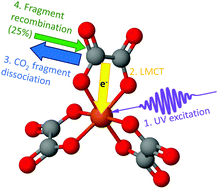Ultrafast photoelectron spectroscopy of photoexcited aqueous ferrioxalate†
Abstract
The photochemistry of metal–organic compounds in solution is determined by both intra- and inter-molecular relaxation processes after photoexcitation. Understanding its prime mechanisms is crucial to optimise the reactive paths and control their outcome. Here we investigate the photoinduced dynamics of aqueous ferrioxalate ([FeIII(C2O4)3]3−) upon 263 nm excitation using ultrafast liquid phase photoelectron spectroscopy (PES). The initial step is found to be a ligand-to-metal electron transfer, occuring on a time scale faster than our time resolution (≲30 fs). Furthermore, we observe that about 25% of the initially formed ferrous species population are lost in ∼2 ps. Cast in the contest of previous ultrafast infrared and X-ray spectroscopic studies, we suggest that upon prompt photoreduction of the metal centre, the excited molecules dissociate in <140 fs into the pair of CO2 and [(CO2)FeII(C2O4)2]3− fragments, with unity quantum yield. About 25% of these pairs geminately recombine in ∼2 ps, due to interaction with the solvent molecules, reforming the ground state of the parent ferric molecule.

- This article is part of the themed collection: Developments in Ultrafast Spectroscopy


 Please wait while we load your content...
Please wait while we load your content...